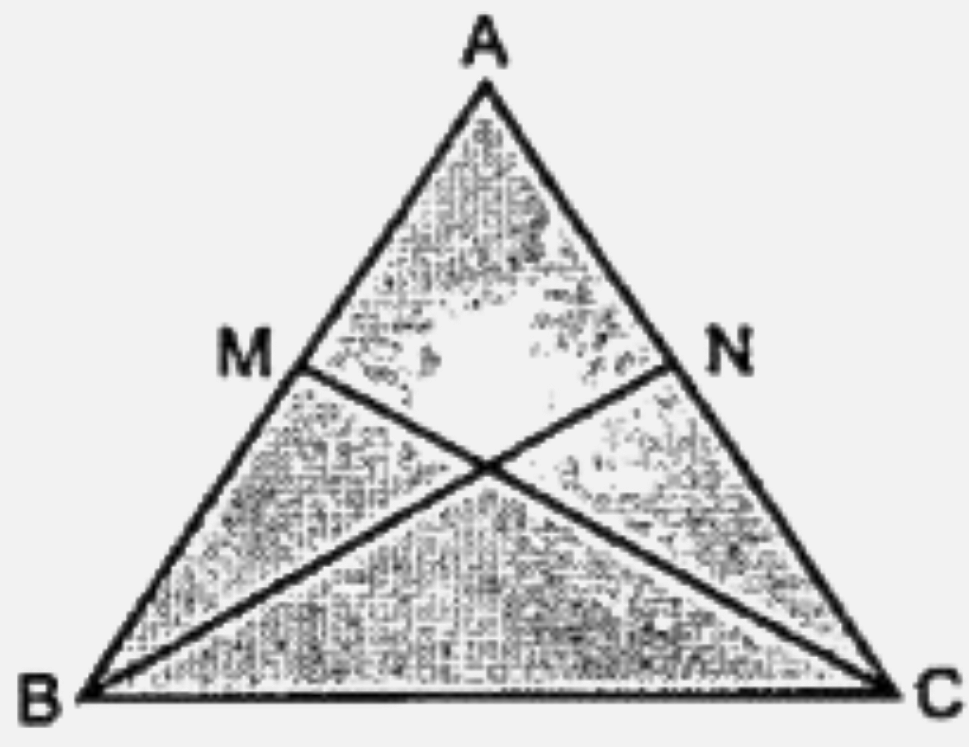The diameters of the circumcirle of triangle ABC drawn from A,B and C meet BC, CA and AB, respectively, in L,M and N. Prove that 1AL+1BM+1CN=2R
To prove that 1AL+1BM+1CN=2R, where R is the circumradius of triangle ABC, we will follow these steps:
Step 1: Understanding the Geometry
We have triangle ABC with circumcircle O and diameters AL, BM, and CN that meet the sides BC, CA, and AB at points L, M, and N respectively.
Step 2: Using the Sine Rule in Triangle OBL
In triangle OBL, we apply the sine rule:
Rsin(90∘−B)=OLsin(90∘−A)
This simplifies to:
RcosB=OLcosA
From this, we can express OL:
OL=R⋅cosAcosB
Step 3: Finding AL
Since AL=OL+OA and OA=R:
AL=R+OL=R+R⋅cosAcosB=R(1+cosAcosB)
This can be rewritten as:
AL=R⋅cosB+cosAcosB
Step 4: Finding 1AL
Now, we find 1AL:
1AL=cosBR(cosA+cosB)
Step 5: Repeat for BM and CN
Using similar steps for BM and CN:
- For BM:
BM=R⋅cosA+cosCcosA
Thus,
1BM=cosAR(cosA+cosC)
- For CN:
CN=R⋅cosB+cosCcosC
Thus,
1CN=cosCR(cosB+cosC)
Step 6: Adding the Three Fractions
Now we add the three fractions:
1AL+1BM+1CN=cosBR(cosA+cosB)+cosAR(cosA+cosC)+cosCR(cosB+cosC)
Step 7: Finding a Common Denominator
The common denominator for these fractions can be expressed as:
R(cosA+cosB)(cosA+cosC)(cosB+cosC)
This leads to a complex expression, but ultimately simplifies to:
2R
Conclusion
Thus, we have shown that:
1AL+1BM+1CN=2R
We have triangle ABC with circumcircle O and diameters AL, BM, and CN that meet the sides BC, CA, and AB at points L, M, and N respectively.
In triangle OBL, we apply the sine rule:
Rsin(90∘−B)=OLsin(90∘−A)
This simplifies to:
RcosB=OLcosA
From this, we can express OL:
OL=R⋅cosAcosB
Since AL=OL+OA and OA=R:
AL=R+OL=R+R⋅cosAcosB=R(1+cosAcosB)
This can be rewritten as:
AL=R⋅cosB+cosAcosB
Now, we find 1AL:
1AL=cosBR(cosA+cosB)
Using similar steps for BM and CN:
- For BM:
BM=R⋅cosA+cosCcosA
Thus,
1BM=cosAR(cosA+cosC)
CN=R⋅cosB+cosCcosC
Thus,
1CN=cosCR(cosB+cosC)
Now we add the three fractions:
1AL+1BM+1CN=cosBR(cosA+cosB)+cosAR(cosA+cosC)+cosCR(cosB+cosC)
The common denominator for these fractions can be expressed as:
R(cosA+cosB)(cosA+cosC)(cosB+cosC)
This leads to a complex expression, but ultimately simplifies to:
2R
Thus, we have shown that:
1AL+1BM+1CN=2R
Topper's Solved these Questions
- PROPERTIES AND SOLUTIONS OF TRIANGLEBOOK - CENGAGE ENGLISHCHAPTER - PROPERTIES AND SOLUTIONS OF TRIANGLEEXERCISE - Concept application exercise 5.1
12 Videos
- PROPERTIES AND SOLUTIONS OF TRIANGLEBOOK - CENGAGE ENGLISHCHAPTER - PROPERTIES AND SOLUTIONS OF TRIANGLEEXERCISE - Concept application exercise 5.2
8 Videos
- PROPERTIES AND SOLUTIONS OF TRIANGLEBOOK - CENGAGE ENGLISHCHAPTER - PROPERTIES AND SOLUTIONS OF TRIANGLEEXERCISE - Archives (Numerical Value Type)
3 Videos
- PROGRESSION AND SERIESBOOK - CENGAGE ENGLISHCHAPTER - PROGRESSION AND SERIESEXERCISE - ARCHIVES (MATRIX MATCH TYPE )
1 Videos
- RELATIONS AND FUNCTIONSBOOK - CENGAGE ENGLISHCHAPTER - RELATIONS AND FUNCTIONSEXERCISE - Archives(Matrix Match Type)
1 Videos
Similar Questions
O is any point in the plane of the triangle ABC,AO,BO and CO meet the sides BC,CA nd AB in D,E,F respectively show that ODAD+OEBE+OFCF=1.
View SolutionLex X by any point on the side BC of a triangle ABC. If XM, XN are drawn parallel to BA and CA meeting CA, BA in M, N respectively; MN meets BC produced in T, prove that TX2=TB x TC
View SolutionConsider △ABC Let I be the incentre and a,b c be the sides of the triangle opposite to the angle A,B,C respectively. Let O be any point in the plane of △ABC within the triangle . AO ,BO ,CO meet the sides BC, CA and AB in D, E and F respectively then ODAD+OEBE+OFCF=
View SolutionABC is a triangle A line is drawn parallel to BC to meet AB and AC in D and E respectively. Prove that the median through A bisects DE.
View SolutionA circle is touching the side BC of a △ABC at point P and touching AB and AC produced at Q and R respectively. Prove that AQ=12(perimeter of △ABC).
View SolutionIn triangle ABC , the internal bisector of ∠A∠Band∠C meet at point I . Prove that :
12(AB+BC+CA)<AI+BI+CI
View SolutionD, E and F are the mid-points of the sides BC, CA and AB respectively of triangle ABC. Prove that:
BDEF is a parallelogram.
View SolutionO is the circumcenter of ABCandR1,R2,R3 are respectively, the radii of the circumcircles of the triangle OBC,OCA and OAB. Prove that aR1+bR2+cR3=abcR3
View SolutionO is the circumcenter of ABCandR1,R2,R3 are respectively, the radii of the circumcircles of the triangle OBC,OCA and OAB. Prove that aR1+bR2+cR3,abcR3
View SolutionThe following figure shows a triangle ABC in which AB=AC. M is a point on AB and N is a point on AC such that BM = CN. Prove that

AM=AN
View Solution
